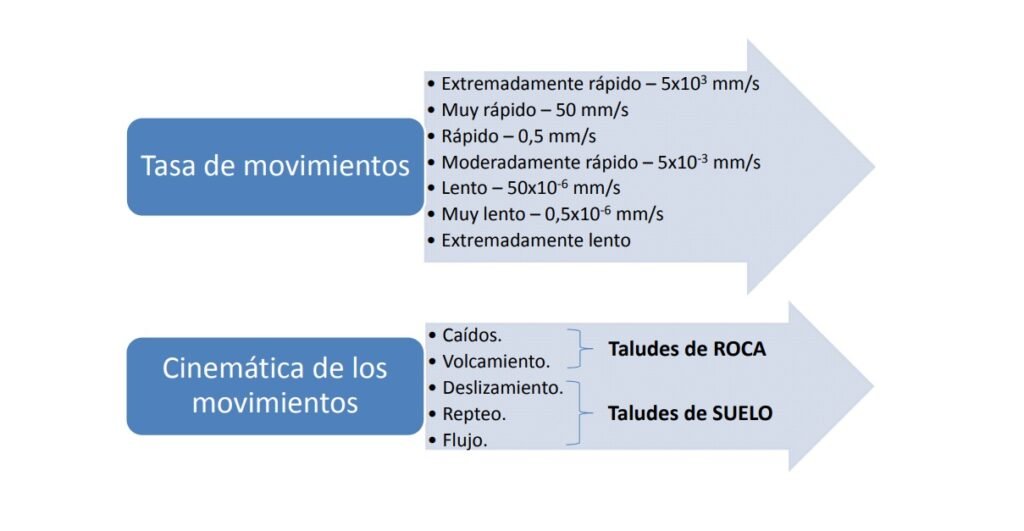

The concept of failure in slope stability analysis
The concept of failure in slope stability analysis involves a great variety of elements of a fundamentally subjective nature, associated to the analysis of the different causes that originated the failure. But, then, what is understood by "failure" of a slope? When is it considered to occur? Read on to find the answers to these questions.
Content
Slope failures or landslides
The concept of slope failure is an aspect that usually generates confusion, mainly because of the extraordinary complexity and multiplicity of what has come to be called "slope failure".
Needless to say, there is no consensus on what should be understood as a failure. The vast majority of failures are defined in terms of landslides or collapses of all kinds, which leave no doubt about the fact that something has occurred that calls into question the structural function of the slope; or in terms of excessive movements, incompatible with the functionality of the slope (Rico and Del Castillo, 1974).
It is common among Geotechnical Engineers to associate the term "failure" with a factor of safety (FS) value equal to 1. In fact, as Huang (1983) points out, the purpose of any slope stability analysis is to determine the factor of safety of a potential failure surface, defined as the ratio of the resisting force to the mobilizing force, both acting on that surface. When the mobilizing force due to the weight of the slope is equal to the resistance of the soil, FS ≈ 1 occurs, and failure is imminent (see Figure 1).
However, the phenomenon of slope failure is something very complex (much more so than determining when FS = 1); mainly because there is a great variety of elements of a fundamentally subjective nature involved in the analysis of a failure, particularly associated with the causes that originated it.

Figure 1 Failure concept: FS ≈ 1 (Source: modified from Wade, 2015. Available at https://slideplayer.com/slide/4261935/).
Therefore, even accepting that the failure of a slope occurs when FS ≈ 1, and also affects the functionality of the slope, the important thing to analyze a slope is to elucidate, as far as possible, the multiple modes in which it can lose its functionality or even collapse, considering each mode as a different problem in genesis, approach and solution.
Factors causing stability failure
Slope failures are frequently generated by processes that either increase the shear stresses acting on the potential failure surface, or significantly affect the shear strength of the soil or rock mass. Figure 2 summarizes these processes.

Figure 2 Factors which contribute to failures and landslides.
Without going into detail about the factors shown in Figure 2, it is evident that some of them are associated with natural forces, and others are related to anthropogenic intervention. In any case, they are destabilizing agents that should be identified and/or evaluated at the time of performing a slope stability analysis.
Failure velocity in slopes and hillsides
Slope and hillside failures occur at different velocities, depending on the characteristics of the fault. Cruden & Varnes (1996) performed an extensive analysis of numerous cases in which landslides occurred, and presented a classification of landslides based on the velocity at which they occur.
As a complement to this information, they also presented a general classification based on displacement kinematics. Figure 3 includes information on what was published by the aforementioned authors.

Figure 3 Classification of slides as function of rate of movements and their kinematics.
According to the information shown in Figure 3, there are extremely high velocities (indicative of brittle faults, speaking a language associated with materials), and practically zero velocities (typical, for example, of natural slopes).
Regarding the kinematics of the movements, usually the first two displacement modes are associated with rock slopes, while the last three are associated with soil slopes.
Mechanisms of slope and hillside failures
Figure 4 presents diagrams illustrating the different types of kinematic mechanisms highlighted by Cruden & Varnes (1996), in both rock and soils. Let us look at some general characteristics of each of these mechanisms.
Let's start with slumps. Landslides consist of the detachment and subsequent fall of materials from the slope, consisting of masses of any size from a steeply sloping slope, in which no significant displacements are visible. Landslides can include anything from soil particles to rock blocks of several cubic meters, and occur at extremely rapid velocities, generally without previous evidence of movement.

Figure 4 Kinematics mechanisms for soils and rocks. In the figure: caídos = slumps; deslizamiento = sliding; volcamiento = overturning; flujo = flow (Source: modified from Suárez Díaz, 1998 – available at https://www.academia.edu/8925280).
Overturning consists of a forward rotation of one or more units of material, whose center of rotation is below the unit's center of gravity. This type of movement can range from very small masses to large volumes of several million cubic meters.
The sliding mechanism of a mass consists of a shear displacement along one or more surfaces, in which the movement is usually progressive (i.e. it is generated in a process that starts at one point and spreads out). Mass displacements can, in turn, be divided into rotational, translational or planar slides, as well as into slides composed of rotation and translation. This differentiation is extremely important because it can define the analysis system and the type of stabilization to be used.
On the other hand, creep is a fault that presents a more or less continuous, and usually slow, process of downslope surface sliding. Creep usually affects large areas, generally with a very low velocity of movement, on the order of a few centimeters per year.
Finally, I would like to mention that in a flow, relative movements of soil particles and/or small blocks occur within a mass moving or sliding over a surface. Normally the internal deformations are very large, and the flow of material is observed in a manner similar to a viscous liquid. The flow, in turn, may be laminar or turbulent, and may transport large blocks to the bottom.
In base of the previous information, we can have a clearer picture of what a slope failure implies, and of the different aspects that must be considered for its analysis.
References
- Cruden, D.M. & Varnes, D.J. (1996) “Landslide Types and Processes”. In Landslides – Investigation and Mitigation. Transportation Research Board Special Report No. 247, National Academy Press, Washington DC, pp. 36-75.
- Huang, Y. (1983) “Stability Analysis of Earth Slopes”. Van Nostrand Reinhold Company. New York, USA.
- Rico, A. y Del Castillo, H. (1974) “La Ingeniería de Suelos en las Vías Terrestres”. Editorial Limusa S.A. Méxido D.F., México.
- Suárez Díaz, J. (1998) “Deslizamientos y Estabilidad de Taludes en Suelos Tropicales”. Instituto de Investigaciones sobre Erosión y Deslizamientos. Bucaramanga, Colombia (disponible en https://www.academia.edu/8925280).